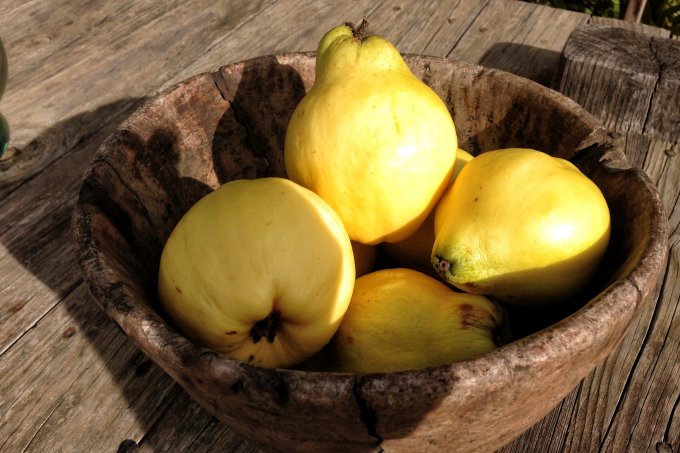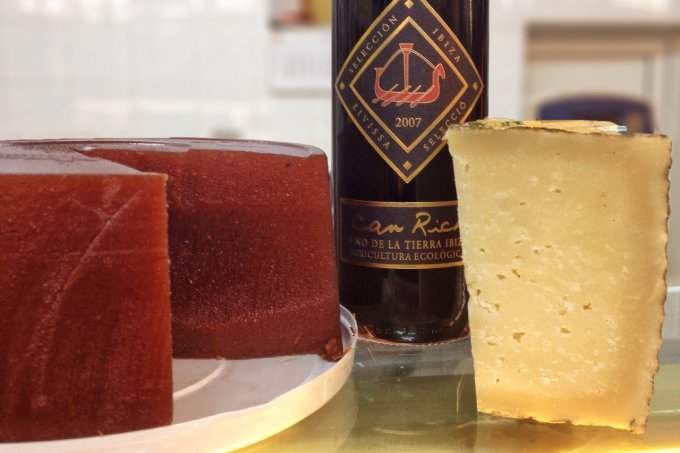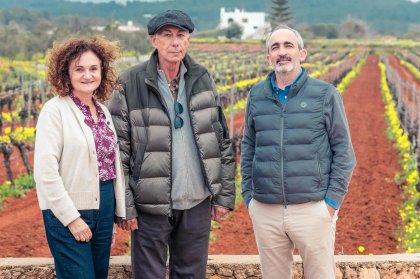It is late in Ibiza's Autumn, the season of the extraordinary quince. Throughout the four thousand year history of its consumption, the ancient and illustrious quince has, quite literally, been the food of the gods, the fruit of great love and legend, and the confection of royalty. It must be the most significant fruit in history. Yet today, it is at the very least, seriously underappreciated, at worst virtually forgotten. But, there is reason behind the reputation. With considered cooking and patience, quince easily transforms into truly sumptuous and divine food. Food well worthy of the quinces place in history.
At first glance, the quince does not seem predisposed to deliciousness. It is a bit lumpy, hard, bright yellow and fuzzy. The fuzz comes off naturally as it ripens, but do rub off any remainder. It requires cooking, often for a long time, but in all cases at least an hour. The quince tree is part of the rose family of trees and shrubs along with the pear, which it most closely resembles. Truly remarkable is its soft and romantic aroma, reminiscent of a sun warmed rose.

It could be from the aroma that the legends of love sprang. The quince was the symbol of love and fertility for the ancient Egyptians. Similarly, it is believed by some to have been a quince rather than an apple given to the Greek mythological goddess of love, Aphrodite. Greeks dedicated it to her as a symbol of love and fertility, using it as an offering in marriage ceremonies. And many historians belief it was a quince that Eve held out in temptation to Adam.
The history of quince and the royal court began with Charlemagne, Charles the Great, the first king of Western Europe, about the year 800. History has it that he was so taken with it, that he directed it be planted throughout the kingdom. Edward the first, 1272, planted the first quince in England at the Tower of London. Throughout Europe since, quince was eaten and celebrated at royal courts, prepared as a confection, reduced down with sugar to solid blocks and carved into elaborate sweet fancies or pressed into molds to create intricate relief like candy preserves.

The most common use of quince today, is the fantastically fragrant Spanish Membrillo or quince paste. Still made with a similar method, it is traditionally eaten at breakfast on toast or served alongside Manchego cheese. Alternatively, melt it to use as a sauce for yogurt mixed with chopped apples and toasted walnuts on top. Strangely, It is also used as an aromatic to flavour cured olives. It can be truly delicious and very versatile.
Membrillo is available in the cheese case of many of the village food shops and in most large grocery stores. It comes as a cake and is sold in wedges. On the higher end, it can be found in individual wooden boxes. Always buy the highest quality available, it is superior, sometimes very much so. Do beware, some commercial Membrillo can taste a bit like Grandmother's floral hand soap. A very good reason to make it at home. Homemade quince paste, though very time consuming is extraordinary, delicious, and hugely impressive.
Quince is not just for Membrillo it can be poached or baked, prepared as a savoury, or more commonly as a dessert. It will take consideration and time, but the kitchen will fill with the aroma of a divine floral incense, reminiscent of romance. There is no better way to put a little love in the air.
Recipes:
Quince Paste:

It is a risk to provide this recipe, it is extremely time consuming and requires infinite patience. But to me the result is so magnificent that the reward outweighs the work. Plan on spending a few hours at this. Make it near Christmas and give it as gifts. I use silpat molds normally used for muffins. They are non-stick and individual sized, I think small size looks better plated with cheese than a wedge. Additionally, they are a good size for gifts. If a straight mold is used, line with plastic wrap for easy extraction.
The amount of quince used is not important as the amount of sugar used is a ratio of 1 cup quince pulp to 2/3 C sugar. I like to do at least 2 kilos of quince as it takes a long time to do and lasts up to nine months or more with occasional re-wrapping.
2k quince: unpeeled, lots of pectin in the skin, cored, bitter seeds removed and quartered.
Sugar: have a couple of kilos on hand
Zest and juice of 2 lemons, preferably organic
Note: rub the cut side of the quince with lemon immediately and place in a bowl of water with lemon juice. This will stop them from turning brown.
Put quince in a heavy bottomed pot, cold water to cover and bring to a boil. Simmer until tender, not falling apart but fork tender like a potato.
Drain thru a jelly bag or a muslin/gauze. The cloth removes cloudy particles making for a clear paste.
Leave the quince in the bag to drain for an hour or so and save the liquid. The liquid can be made into quince/apple jelly very easily.
Mash the pulp in a bowl with a potato masher to break it up a bit and pass thru a molina, making a pulp.
Measure the pulp 1 cup to 2/3 cup sugar and add it to a very heavy bottomed pan. A cast iron and enamel, Le Crusset for example works well. It takes patience to really control the heat, but it makes it easier to cook and burns less.
Add the paste, sugar, zest and lemon juice, start the heat on low, let the sugar melt and the paste incorporate.
Increase the heat to medium, using a wooden scraper, stir the bottom frequently. As in do not leave the kitchen, please do not let it burn as there is no way back, but to begin again. It will bubble and burble, take care with hands and eyes. Control the heat a bit, so as not to let it get out of control. Remove it from the heat for a minute or so if feeling insecure. Continuous care ensures a fabulous result.
Gradually the colour will change to a deep orange and it will thicken, it is done when it the paste needs to be shaken off the spoon.
Spoon in to molds, pushing down to fill nooks, even off the tops with a spoon or an offset spatula.
Leave to cool completely, un-mold and wrap in wax paper.

I might have asked too much in supplying this recipe, but as in the quince paste, the accompanying quince apple jelly made with the quince water is just fantastic and well worth making. If interested in giving it a go, please email me at Ibiza Spotlight (Subject: For the attention of Organic Annie) and I will send the recipe along.
Spiced Baked Quince:

The recipe comes from Hugh Fearnley-Whittingstall's River Cottage, a cook I admire for his passion for giving the unknown a go and making it divine. It is dead easy, great for autumn dinner parties.
3 Quince, halved and cored
juice of 1/2 lemon
200 ml sweet Spanish red wine
5 T runny honey
3 cinnamon sticks2 star ansie
18 cloves
Yogurt, cream or vanilla ice cream for serving
Put three cloves in each quince half and place in buttered baking dish skin side down.
Whisk 400 ml water plus remaining ingredients together and pour over quince.
Bake in a 180/350 oven for an hour or so. Flip quince and bake until tender.
Remove from oven, remove quince to a pie plate to cool. if the liquid is too runny or watery, boil down in a sauce pan on stove top until thick and syrupy.
Plate and serve with a scoop of something creamy, spoon sauce on top.
Editors Note

Yesterday I taste tested Annies homemade quince vs. shop brought. Whilst Annie and I both agreed the Spanish Membrillo at Can Curune supermarket was exceptional, there was no denying Annies own was better in both texture and taste!
Annie kindly gifted me some and it was enjoyed with grilled Manchego cheese on toast this morning, for breakfast - highly recommended!
Bon profit!







